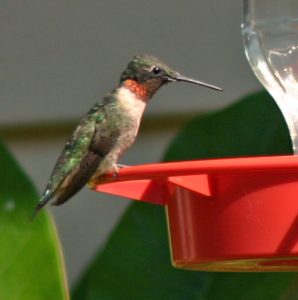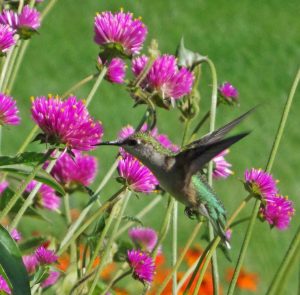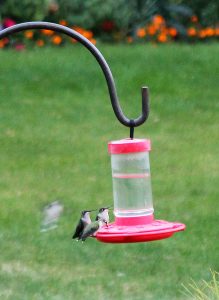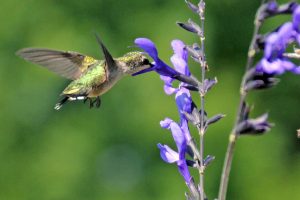
There are about 330 species of hummingbirds, the second largest family of birds (Trochilidae), all native to the Americas from south central Alaska to Tierra d
el Fuego, and the Caribbean, with the greatest species diversity found in tropical and subtropical Central and the northern Andes of South America. The common name comes from the sound created by wings beating in a figure-8 pattern at such high frequencies (up to 80 beats per second) they are audible to humans. These small birds are able to hover, travel up to over 30 miles per hour, and fly backwards and even upside down. Most species are only 3-5 inches long, with the smallest, the bee hummingbird, at only 2 inches long and less than an ounce in weight. Most have plumage with iridescent colors resulting from a combination of pigmentation and refraction from prism-like cells in the upper layers of the feathers.

These tiny creatures have an extremely high metabolism, with a heart rate up to 1,260 beats per minute and 250 breaths per minute. This is necessary to support such rapid wingbeats during hovering and fast forward flight, and therefore they need tremendous amounts of food to sustain themselves. To conserve energy they can enter a state of torpor – similar to hibernation, where their temperature, heart rate and breathing rate decreases dramatically and metabolic rate slows to 1/15 of its normal rate – at night or when food is scarce. Unlike most animals, they are able to quickly make use of ingested sugars to fuel their flight muscles and all depend on flower nectar to fuel their high metabolism, reserving their limited fat reserves for overnight fasting and migratory flights. They do feed on small insects in flight or on leaves and spiders to obtain protein and other nutrients.

Hummingbirds and nectar-rich plants co-evolved over millions of years from the swifts in South America, with the nine major groups of these specialized nectarivores having a diversity of bill lengths and shapes that coordinate with specific flower shapes. Long bills allow the birds to probe deep into flowers with long corollae; short, sharp bills evolved for feeding from flowers with short corollae and piercing the bases of longer ones; curved bills are adapted to extracting nectar from curved corollae. The many different flower and bill shapes allow many hummingbird species to coexist in a particular region. When feeding on nectar, the bill opens slightly, with the long, extendable tongue darting in and out inside the flower to rapidly lap up the nectar. Plants that are hummingbird-pollinated often have flowers in shades of red or orange, even though the birds will feed on tubular flowers of other colors.

These types of flowers generally do not reflect near-ultra-violet wavelengths that act as landing guides for insect pollinators. They also tend to produce relatively weak nectar with a high proportion of sucrose compared to insect-pollinated plants that tend to produce more concentrated nectar composed primarily of fructose and glucose. The sugar concentration and composition of nectar varies greatly across plant species and over time, usually in the 10 to 35% range (from as weak as 10:1 to as strong as 1:1, although both of the extremes are rare, with an average sugar content close to 3:1). Feeders filled with sugar water (white granulated sugar at a 3:1 to 4:1 water to sugar ratio) can provide a reliable food source when flower blossoms are not abundant. Weaker solutions (such as 4:1 or 5:1) are best during hot, dry weather when the birds need more water.
Hummingbirds adapt readily to human habitation and nearly all species will visit feeders. They will also nest in protected locations on loops of chain, wire, cords and other man-made structures even though normally they would construct their nest in a deciduous or coniferous tree or shrub.


There is only one common hummingbird species in the Midwest, the ruby-throated hummingbird (Archilochus colubris), which breeds from the southeastern US to Ontario, Canada (a few other species can occasionally be seen, but do not breed east of the Mississippi). This small (3 to 3.5 inch long) solitary hummingbird is green with gray-white underparts and the smaller males have an iridescent red gorget (throat patch) that appears dull black when not oriented at the right angle. They have a slender, straight to slightly downcurved bill. They live in semi-open habitats such as suburban backyards, parks, gardens, meadows, open woodlands, and forest edges.

Females build a nest of plant fibers, bud scales, and grass tied together with spider webs camouflaged with lichens or dead leaves and lined with plant down (such as dandelion or thistle down) or animal hair on a small, downward-sloping tree branch, then incubates the two white eggs and feeds the young (mainly insects) by herself. They produce one to two broods each summer. Both males and females are territorial, aggressively attacking and chasing other hummingbirds in their feeding territory.
This species migrates annually to spend the winter in rather open or dry tropical scrub in southern Florida or Texas, Mexico, or Central America. In late summer and fall, the ruby-throated hummingbird gains as much as 100% of its body weight in order to be able to fly across the Gulf of Mexico on a nonstop flight during its annual migration from North America to overwintering areas. The males leave first, sometimes beginning their migration by early August.

The best way to encourage these small birds to remain in a landscape is to grow a diversity of nectar-producing flowers they prefer and have feeders as a supplement especially when blooms are scarce. In addition to having staggered bloom times to have a food source for the entire season, a source of water and trees or tall shrubs for nesting and perching will encourage them to stay. Avoid using pesticides that would indiscriminately kill the small insects these birds feed on. Flowers don’t have to be planted just in the garden, as hummingbirds will readily visit flowers in containers, too.

I usually have some self-seeded Texas or scarlet salvia (Salvia coccinea) that I allow to grow in the containers of other plants in my greenhouse. I can then move those that are blooming in early spring outside before anything is flowering in my yard for the early arrivals. Once hummingbirds discover a patch of flowers, they are likely to continue visiting throughout the season and will usually return the following year. Gardens planted with all hummingbird plants will attract more birds, but even putting in just a few highly attractive plants in existing gardens will encourage the birds to visit.

Although they show a slight preference for red, orange, and bright pink tubular flowers, there are many others they will feed on just as readily, such as ‘Black and Blue’ salvia (Salvia guaranitica). Hummingbirds will visit a LOT of different plants, including many not on their list of favorites (and just because a plant is on the list doesn’t mean it will utilize that plant in all areas). Keep in mind that, in general, single flowers are better than double flowers; some cultivars or hybrids may have much less nectar than the species; and patches of flowers tend to be better than individual plants spaced widely throughout a landscape. The following list is a compilation from many sources of common plants that are attractive to hummingbirds, but there are many more plants that ruby-throated hummingbird will feed on besides these. Those marked with an asterisk (*) are considered by many to be the very best plants to grow in the Midwest as hummingbird plants.
| Species | Plant type |
| Agastache rupestris | Tender perennial grown as an annual |
| Aquilegia canadensis, Eastern red columbine | Native perennial |
| Asclepias spp. esp. currasavica, but also A. syriaca, common milkweed and others | Annual and native perennials |
| Buddleia davidii, butterfly bush | Marginally hardy perennial in most of WI |
| Campsis radicans, trumpet vine | Native woody vine |
| Canna indica, canna | Tender perennial grown as an annual |
| Cleome hassleriana, spider flower | Annual |
| *Cuphea spp., including C. schumanii, C. llavea, and hybrids, esp. ‘David Verity’ and others | Tender perennial grown as an annual |
| Delphinium exaltatum, perennial larkspur | Native perennial (to zone 5) |
| Digitalis grandiflora, yellow foxglove | Perennial |
| Digitalis x mertonensis, strawberry foxglove | Short-lived perennial |
| Digitalis purpurea, common foxglove | Biennial |
| Fuchsia triphylla ‘Gartenmeister’ | Tender perennial grown as an annual |
| Heuchera sanguinea, coral bells | Native perennial |
| Hibiscus syriacus, Rose of Sharon | Marginally hardy perennial in most of WI |
| Hosta | Perennial |
| Impatiens capensis, jewelweed (red only, yellow is not attractive) | Native annual |
| Ipomoea coccinea, red morning glory | Tender perennial grown as an annual |
| Ipomoea sloteri, cardinal climber | Tender perennial grown as an annual |
| Ipomopsis rubra, Spanish larkspur | Tender perennial grown as an annual |
| Justicia brandegeana, shrimp plant | Tender perennial grown as an annual |
| Kniphofia uvaria, red hot poker | Marginally hardy perennial in most of WI |
| Lantana camara and hybrids, especially red ones | Tender perennial grown as an annual |
| *Lobelia cardinalis, cardinal flower | Native perennial |
| Lobelia siphilitica, great blue lobelia | Native perennial |
| *Lonicera sempervirens, coral honeysuckle | Native woody plant |
| *Monarda didyma, beebalm | Native perennial |
| Nepeta spp., catmint | Perennial |
| Penstemon spp. | Annuals and perennials |
| Phaseolus coccineus, scarlet runner bean | Annual vine |
| Phlox paniculata (tall garden types) | Perennial |
| Salvia azurea | Southeastern US native perennial (zone 5) |
| *Salvia coccinea, Texas or scarlet sage | Tender perennial grown as an annual |
| Salvia elegans, pineapple sage (but rarely blooms in upper Midwest before the ruby-throated hummingbirds migrate south for the winter) | Tender perennial grown as an annual |
| Salvia exserta, Bolivian sage | Annual |
| Salvia greggi ‘Hot Lips’, ‘Navajo Red’ and others | Tender perennial grown as an annual |
| *Salvia guaranitica, blue anise sage | Tender perennial grown as an annual |
| Salvia splendens | Tender perennial grown as an annual |
| Salvia hybrids (incl. ‘Indigo Spires’, ‘Phyllis Fancy’; ‘Purple Majesty’ and many others) | Tender perennial grown as an annual |
| Tithonia rotundifolia, Mexican Sunflower | Annual |
| Verbena spp. and hybrids | Annual |
| Weigela florida | Native woody plant |
| Zinnia elegans, some tall red or orange varieties | Annual |
– Susan Mahr, University of Wisconsin – Madison
Additional Information
- Hummingbird Gardening in the Upper Midwest – private site by Michael and Kathi Rock in Madison, WI
- Container Plants That Attract Hummingbirds – a video segment from The Wisconsin Gardener (first aired July 2010) on the WPT website
- How to Create a Hummingbird-Friendly Yard – on the Audubon website
- Plants and Flowers to Attract Hummingbirds – on the Birds & Blooms website
- Super Hummingbirds – a Nature episode, video available on PBS





 Marigolds
Marigolds Create a Butterfly Garden
Create a Butterfly Garden Plant Flowers to Encourage Beneficial Insects
Plant Flowers to Encourage Beneficial Insects Forcing Bulbs
Forcing Bulbs


